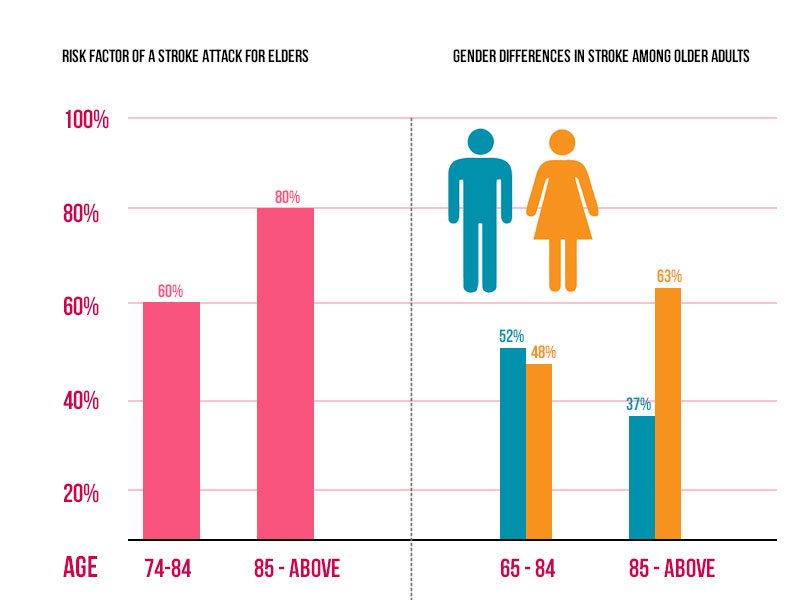Stroke in the Elderly
by admin-blog-kh | November 2, 2015 7:00 am

Stroke, as per statistics, is the leading cause of impairment and the third leading cause of death among the elderly, in India. Stroke is also the cause of disability and pre-mature death in the rural, semi-urban and urban regions of India. To a large extent, the poor who have been exposed to the risk factors, basically have no knowledge of how to act in the event a loved one has an attack of stroke, nor do they have the means to meet the high cost for stroke care.
The primary non-modifiable risk factor for an attack of stroke is age. The risk factor of a stroke attack for elders in the age group of 74-84 have been determined to be 60% and for those 85 years of age and beyond, the risk factor has been determined to be around 80%. The gender of the elder also plays a significant part in the outcomes, treatment and epidemiology of geriatric stroke. It is important to recognize gender differences to enable better outcomes and treatment. Though the entire aged population are at a risk of a stroke, the incidence of stroke is higher in men in the age group 65 to 84 years (men 52%, women 48%) but greater in women at 85 years and above (men 37%, women 63%).A vascular neurologist will take these factors into consideration and treat accordingly.
Some of the common disorders among the elderly include:
- Silent Strokes
- Other unrecognized brain abnormalities
- Aneurysms
- Benign Brain Tumors
Generally, the tendency of many people is to ignore the small stokes or in some cases, may be ignorant of the signs that are associated with a stroke. However, a stroke does give prior warnings of an impending attack. Therefore being aware of what those signs or symptoms are is important. A sudden attack of any of these symptoms is an indication of an impending attack of stroke. It would be best to consult a vascular neurologist immediately if any of these symptoms are experienced. It would be best to consult a vascular neurologist[1] immediately if any of these symptoms are experienced.
- Weakness, numbness or paralysis occurring in the facial region, arms or legs
- Inability to speak properly, may feel confused or have trouble understanding
- Temporary loss of vision in either eye, rarely in both
- May feel dizzy, have trouble walking, maintaining balance or coordination
- Severe headaches[2] for no apparent reason
Strokes of any type are categorized under two major categories – Ischemic and Hemorrhagic.
Ischemic Stroke

The term Ischemia refers to the condition where there is insufficient supply of blood to a particular region. Hence, blockages of blood supply to the heart, brain, etc are called an Ischemic attack. The more common of the two types of strokes, is Ischemic stroke. During an Ischemic stroke[3], blood clots or formation of plaque, block the blood supply to the blood vessels in the brain. The blood clot(s) forms along the walls of the blood vessel or in some cases fat deposits narrow the passage in the blood vessel, thus causing a thrombotic stroke. Many times, due to high blood pressure levels, the blood vessel may also be damaged. A blood clot or an embolus occurring in another part of the body, can travel to the brain region and block the blood vessel (s) there, causing an embolic stroke or cerebral embolism. An embolic stroke, more commonly occurs when the blood clot travels from the heart, after a heart attack or when atrial fibrillation (irregular heartbeats) occur.
Hemorrhagic Stroke
When a blood vessel in the brain bursts or there is leakage of blood into the brain, a hemorrhagic stroke occurs. Hemorrhagic stokes do not occur as commonly as the Ischemic stroke. They are categorized into two types – Intracerebral and Subarachnoid hemorrhages.
Leakage of blood from a broken blood vessel in the brain, damages the brain cells and also cells beyond the area of the broken blood vessels, which die due to lack of blood supply. This condition is referred to as intracerebral hemorrhagic stroke.
In a Subarachnoid hemorrhagic stroke, a blood vessel that is close to the surface of the brain breaks, and the blood collects between the surface of the brain and the skull, causing irritation to the lining of the brain. This is also a very painful condition.
Act on a TIA
Be aware of the mini stroke or Transient Ischemic Stroke (TIA), which is a temporary forewarning of an impending stroke. It may last for a few minutes or for an hour or two, as the block that occurs, quickly clears up by itself. However, this is definitely a sign / symptom of a full blown Ischemic stroke, which could occur anytime soon, even the same day. Consequently, an immediate medical evaluation will help stave off dire consequences.
Kauvery Hospital is globally known for its multidisciplinary services at all its Centers of Excellence, and for its comprehensive, Avant-Grade technology, especially in diagnostics and remedial care in heart diseases, transplantation, vascular and neurosciences medicine. Located in the heart of Trichy (Tennur, Royal Road and Alexandria Road (Cantonment), Chennai, Hosur, Salem, Tirunelveli and Bengaluru, the hospital also renders adult and pediatric trauma care.
Chennai – 044 4000 6000 • Trichy – Cantonment – 0431 4077777 • Trichy – Heartcity – 0431 4003500 • Trichy – Tennur – 0431 4022555 • Hosur – 04344 272727 • Salem – 0427 2677777 • Tirunelveli – 0462 4006000 • Bengaluru – 080 6801 6801
- consult a vascular neurologist: https://www.kauveryhospital.com/doctors/chennai/vascular-surgery
- headaches: https://kauveryhospital.com/blog/neurology/what-kind-of-headache-do-you-have-what-could-be-the-cause/
- Ischemic stroke: https://kauveryhospital.com/blog/neurology/ischemic-stroke-what-is-it-causes-and-symptoms/
- Atrial Fibrillation And Embolic Strokes: https://kauveryhospital.com/blog/cardiology/atrial-fibrillation-and-embolic-strokes/
Source URL: https://www.kauveryhospital.com/blog/neurology/stroke-in-the-elderly/